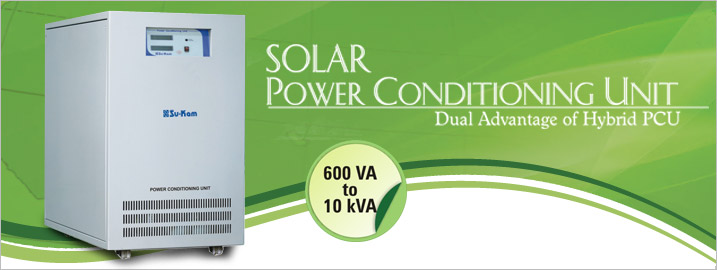
What is a SPCU (solar power conditioning unit)? What’s the difference between an inverter and a solar charger?
- Comments are off.
- Comments are off.
Solar Power Conditioning unit (SPCU) is an integrated system that provides the facility to charge the battery bank through either a Solar or Grid/DG set.An SPCU (solar power conditioning unit) will consist of the following parts:
- Solar charger
- Inverter
- Grids (main utility) charger
- Output selector mechanism
- Battery mechanism
- Control algorithm
Solar Charger : The sole purpose of the solar charger is to convert the solar energy collected by the photo voltaic panels to charge the battery. There are basically two types of solar chargers available in the market :
PWM type:in this type the panels are directly connected to the battery through an electronic switch. The PV panels are considered as a current source and it delivers current at a voltage equal to the battery voltage plus the drop across the switching element. This is a very low cost charger. The main drawback here is that the SPV voltage is controlled by the battery voltage and because of this the PV panels don’t operate at its peak voltage and hence efficiency is less. For switching the panel to the battery either a combination of MOSFET and diode is used or a Zero drop type switching is used.
MPPT Charge control: In this type an electronic conversion unit changes the voltage of the solar panel to the battery level. Here since the panel voltage is independent on the battery voltage level, the panels are operated at its peak power point. Hence utilization of the panel is maximized. This is used for larger systems and this is costlier than PWM type.
Inverter : In simple terms this is the heart of the solar PCU. This part is responsible for converting the DC voltage from the battery to SC power to the output. There are different technologies that exist for inverter. In the transformer based inverter, the dc-ac inversion happens at low voltage of the battery and then it is stepped up using a transformer. This technology is being replaced by High efficiency switched mode power supply (SMPS) based inverter around the world. The SMPS is used to transform the dc current to high voltage DC and it is then inverted.
Grid Charger : It is an auxiliary charger in a Solar PCU. It charge’s the battery from the grid when solar is not available. Different type of chargers are available in the market. Some inverters are even bi-directional and have the ability to charge the battery in the reverse direction from the grid.
Selector Mechanism : The system is always placed in the solar mode, under this condition the power from the PCU will be coming from the inverter. But when solar energy is not sufficient enough the appliances will be operated from the grid. This is made possible with the help of a relay.
Battery bank : The battery bank stores the solar charge for use by the inverter. In a normal day solar energy keeps varying depending on cloud formation, shadow and time of day etc. The loads connected to the inverter will also be having its own variations in loading pattern. Hence it is very essential to have a battery backup to act as a buffer and for storage of electricity produced through solar. Use C10 tubular batteries which are available in the market exclusively for solar systems.
Control Algorithm
This is the part which distinguishes a solar PCU from an ordinary inverter + solar charger. This is the part which controls the priority and optimally select which is the source of charging solar or grid or both. It also selects the source of ac output to be either from the inverter or from the grid. It can operate in either Solar-Battery-Grid or as Solar-Grid-Battery. In solar-battery-grid, the battery is charged first and also supports the inverter to power the appliances. Once the solar energy stops, the PCU starts consuming the stored energy from the battery. Once the stored energy is used to a particular level, the inverter stops and the connections to the appliances is given from the grid with the help of output selector. The main focus here is to save the electricity bill cost. In the solar-grid-battery mode of operation, the battery is first charged with the help of solar and also supports the inverter to power the appliances. Once the solar energy stops coming, the appliances are run with the help of the grid using the output selector. The battery is not discharged in this case till there is a grid failure. This type is used at places where power outage is more and the consumer wants to use the grid as long as it is available. The battery is kept as a backup to use when the grid fails. In this condition at day time the load will work in solar power. Here the main purpose is to have uninterrupted solar power. The efficiency of the inverter is one of the most important factor which decides the overall cost of the system. For eg transformer based inverter has only 70% efficiency, while for SMPS based high frequency inverter the efficiency is 90%. In short it is very important to choose the right type of technology for a solar PCU. Not doing so, one would never get the real benefit of the installed solar system.












